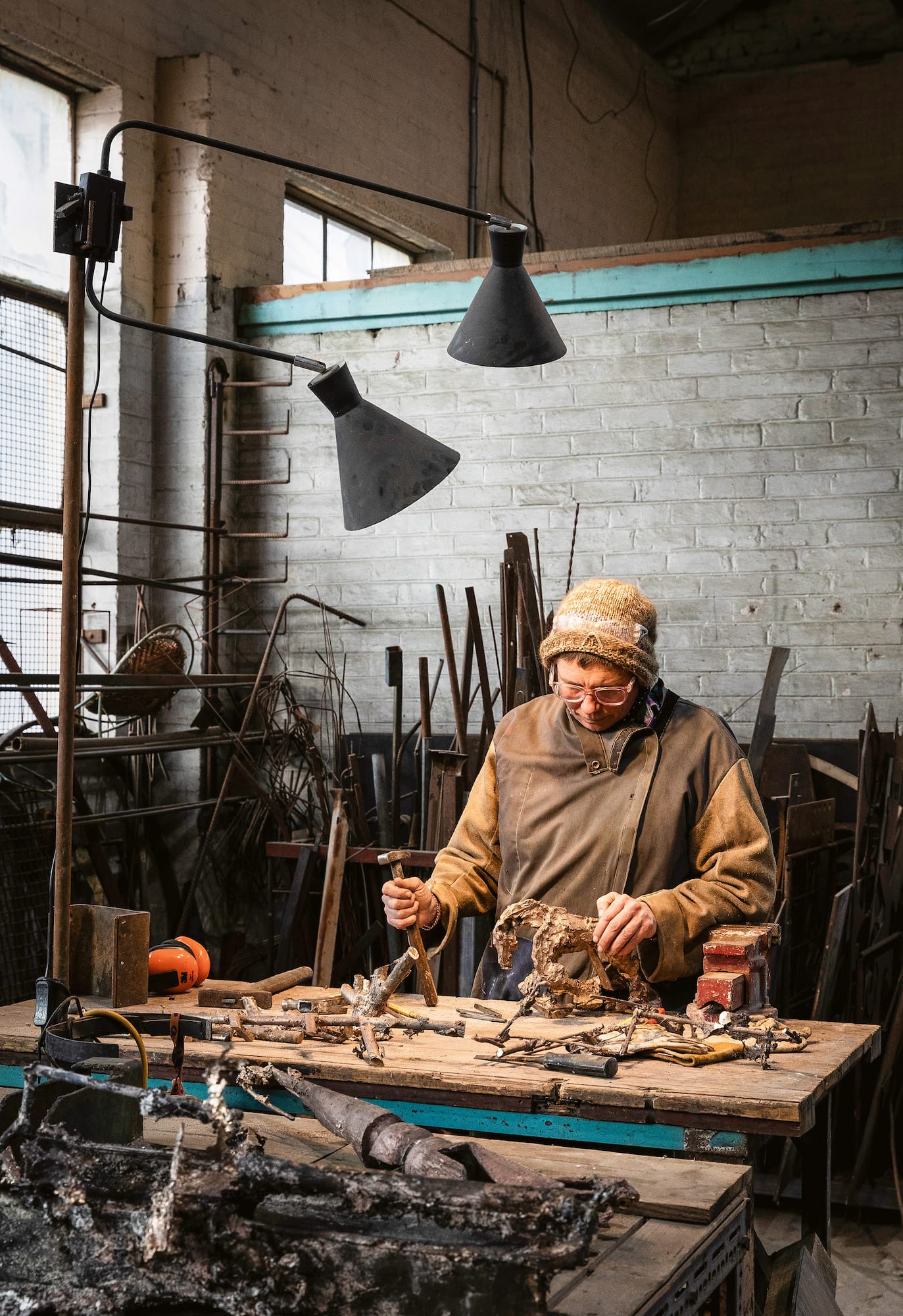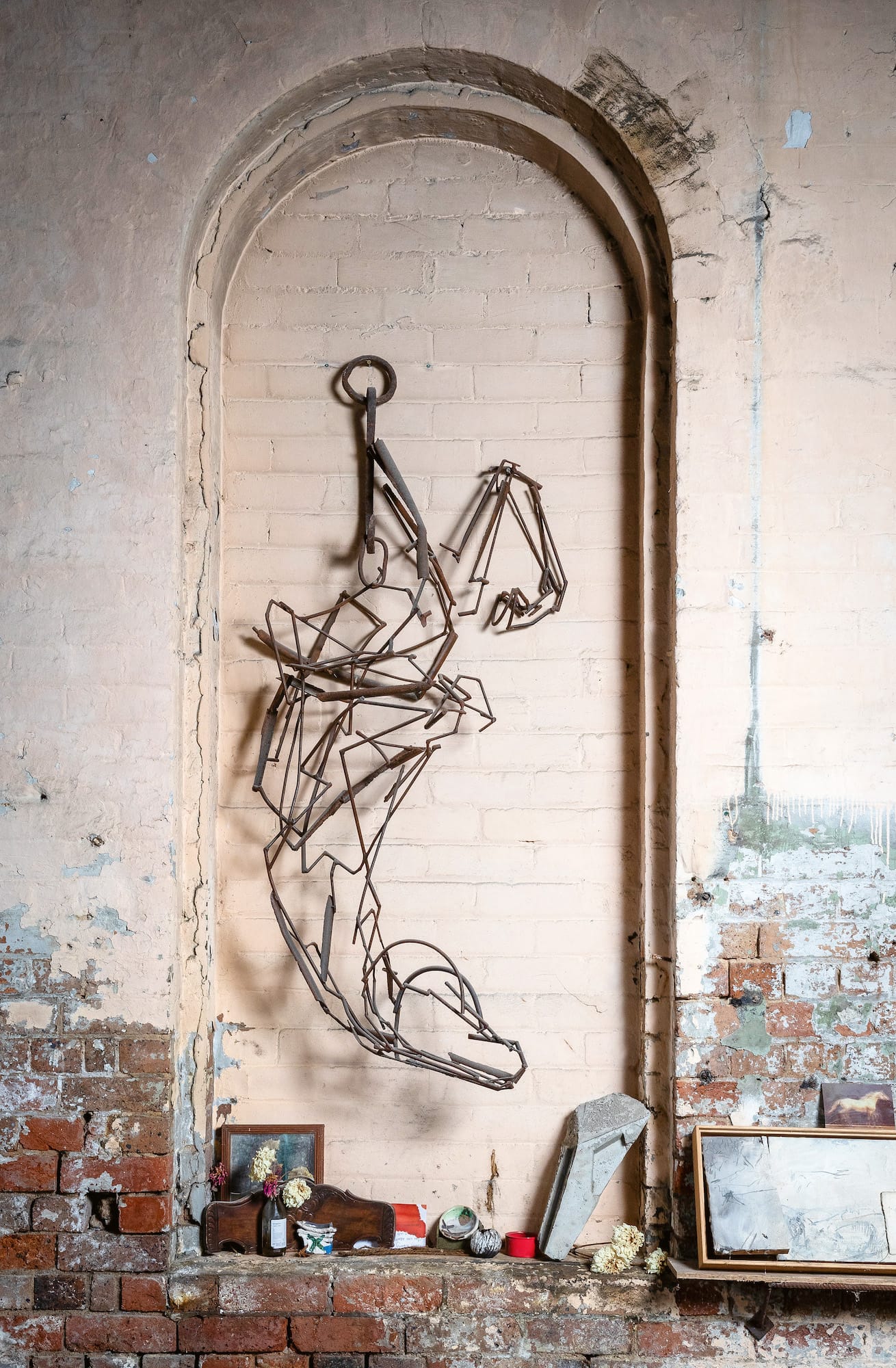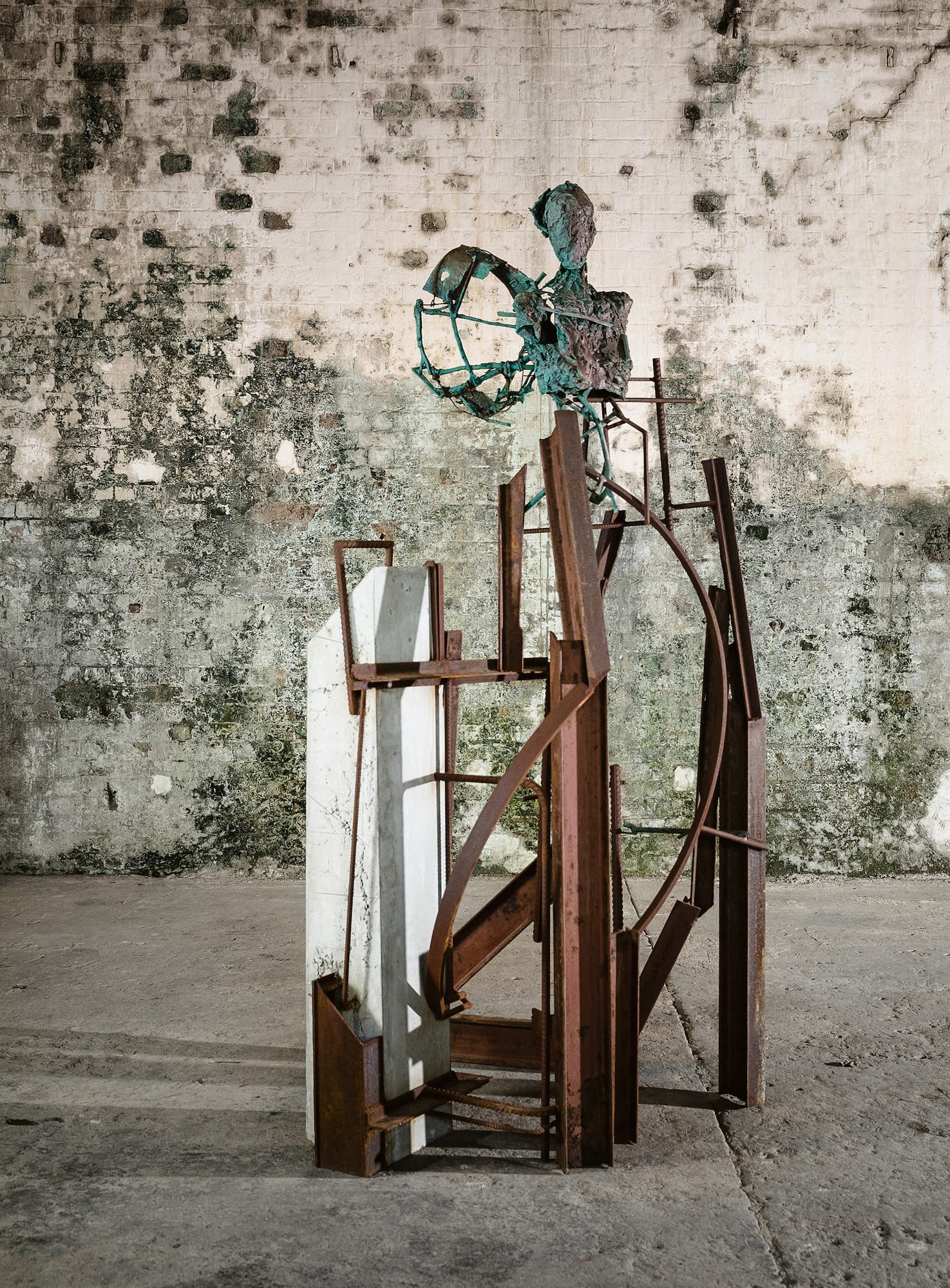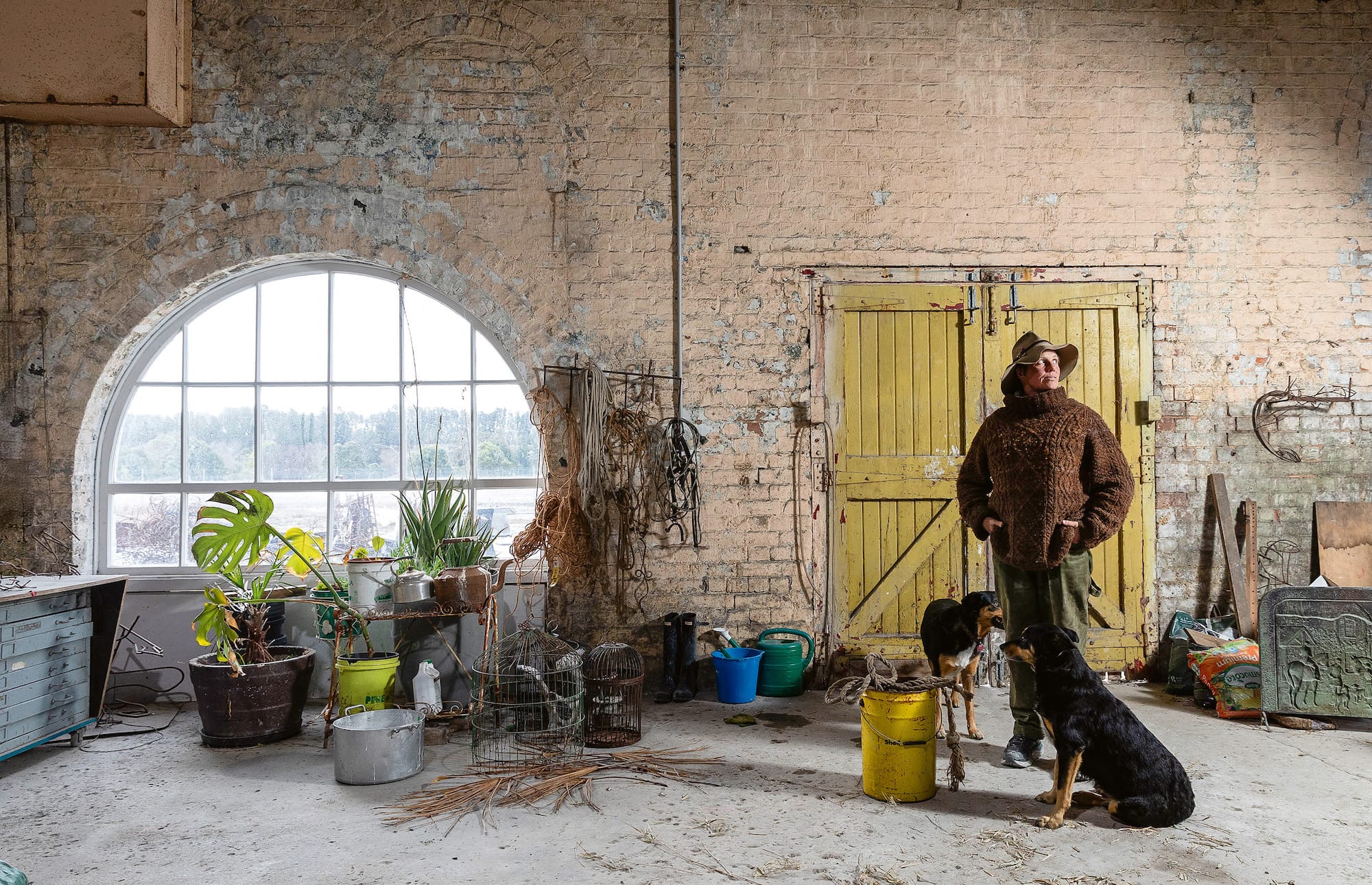
There’s alchemy afoot when sculptor Harrie Fasher transforms molten bronze into figures that demand to be touched.
Words Lenny Ann Low
Photography Jennifer Leahy/Silversalt
ON a bracing afternoon, Harrie Fasher leads the way across a vast, undulating landscape of construction rubble, scrubby grass, gravel tracks and dark green trees.
Up ahead, beyond silos, a towering brick chimney and her studio inside a cavernous building at the former Portland Cement Works, Fasher has spotted her cows waiting in the late afternoon sunshine.
“One,” she says, walking towards a russet-and-white Hereford, “prefers a hug more than the other.” In minutes she’s down on her knees, arms wrapped around The Pig, a 12-year-old cow she has owned since it was weeks old. Huge and placid, the cow’s long, pale eyelashes glow in the sunlight as it leans against Fasher, gently dislodging her felt hat.
“There’s no better mental health than hugging an animal like her,” Fasher says, scratching The Pig’s soft, warm hide. “She used to look like Shirley Temple and now, look at you. So beautiful.” Her other cow, Splodge, is named after his likeness to a daub of black paint on the landscape.
Animals play a big role in the life and art of Fasher, an award-winning sculptor who has built her own foundry here, on the outskirts of her current home of Portland, a small town about 40 minutes’ drive east of Bathurst in the New South Wales Central Tablelands. At her side is The Bird, a black-and-tan dog who comes flying when Fasher whistles. “It’s his job to know where I am, as opposed to my job to know where he is,” she says, patting his haunches. “We made that rule early on.”

Way off, against the silhouettes of a pair of 19th-century brick bottle kilns – remnants of the site’s early cement-making process for Kangaroo brand cement – are Fasher’s horses, Evie and Dusty.
Opened in 1902, the Portland Cement Works was once a thriving industrial site giving Portland the title “the town that built Sydney”. Before closing in 1991, cement made here was used in roads, bridges and buildings, including the Commonwealth Bank’s “money box” building on Pitt Street.
In 2012, sections were added to the NSW State Heritage Register and the site, now known as the Foundations Portland, is in the process of being converted into an arts, culture and tourism centre with neighbouring areas zoned for residential development.
At the centre of the site’s majestic early 20th-century buildings and four decommissioned limestone quarries is the Portland Foundry, a huge workshop – 980 square metres – with lofty ceilings and tall windows, incorporating Fasher’s studio.
“It’s not small,” she says looking across a space that could house jet planes.
Her truck, Buttercup, fixed with a crane capable of lifting five tonnes, is visible through a doorway. Inside is her forklift, named The Farmer as a nod to her friend Geoff Salmon, who helped move Fasher’s heavy and large sculptures at her former studio on his Oberon farm.
“I tell you, a forklift is a woman’s best friend,” she says, patting it.
Perhaps because tactility, shape and texture ignited her love of sculpture, Fasher pats and touches almost every object, animal and sculpture she passes.


“This is one of my darlings,” she says, clapping a hand on a life-size equine concrete sculpture in another building near the foundry. A multimedia installation made in 2022, The Space Behind merges stop-motion animation, a reclaimed truck tarpaulin and a range of materials: concrete, hessian, canvas, felt, steel rope and hemp rope.
Fasher runs a hand down the horse’s head, its assemblage of grey, coarse-edged cast blocks embodying the sweep of an animal’s gaze towards an outstretched hand. She explains its creation, a process involving steel “reo” framework, moulds of timber formwork and poured concrete. “This work is one that’s made people cry,” she says. “It’s cold, it’s hard, it’s concrete. And yet it feels like it could move. It feels like it has a presence.”
This might be the essence of Fasher’s sculptural practice. Her works – abstract and figurative, formed from bronze, concrete, steel, rope and found objects collected in India, Mongolia, Bhutan and around Australia, including piles of excavated concrete rubble resting on site – are alive with an almost imminent movement. Like a camera shutter freezing them mid-blink.
There’s evidence everywhere of her connection with horses, animals she “found solace with as a child” growing up between inner-city Sydney and the Hawkesbury region. After competing professionally in eventing, training horses and setting up a riding school, a fall in her 20s triggered the end of her equestrian career.
It was while studying at the National Art School in Sydney from 2007 that she discovered a love for sculpture. “What drew me to sculpture was materials,” she says. “I love texture, the weights of things.”
Fasher is perhaps best known for The Last Charge, a collection of eight steel horses exhibited at Bondi’s Sculpture by the Sea in 2017. Representing the 800 horses of the last charge of the Light Horse Brigade at the Battle of Beersheba in October 1917, the work’s horses – seven in full gallop and one fallen on the ground – represent the chaos, tragedy and sacrifice of war.
“Horses to me aren’t just this regal, beautiful connection,” she says. “They have a lot of trauma and heartbreak.” She runs her hands across another horse sculpture, lying prone across blue fabric.
A work in progress lies on a table laden with rope, horse forms, wax sticks, Icelandic bird bones, a cockatoo skull and a female bust figure in wax. It’s part of a 3.5-metre-high scaffolded goddess creature that Fasher is creating for a major solo exhibition at Orange Regional Gallery opening in November. Plinths hold more bronze pieces. “Curiously, this Orange exhibition is bringing me back to the material nature of things,” she says.
Outside, we’ve passed piles of excavated concrete rubble, some earmarked with dashes of pink paint by Fasher and her sister, Kim, also an artist, for collaborative sculptures shown in a recent group exhibition, Creative Foundations, at the Blue Mountains Cultural Centre. And we’ve glimpsed a limestone quarry, now a lake 85 metres deep filled with turquoise water where Fasher swims, describing it as “so cold, it’s like your lungs explode”.
But within Fasher’s foundry, temperatures reach positively volcanic heights. She casts in bronze, a complex, hazardous practice in which molten bronze (formed from copper, tin and zinc) reaches temperatures nearing 1000 degrees. It requires skill, forethought, strength and nerve, and while casting in bronze is not uncommon, running your own foundry is.
Fasher uses the “lost wax casting” method. She creates a wax model, builds a plaster mould around it, slowly melts the wax away and then pours molten bronze into the “void” or cavity left behind. Once cooled, the final bronze sculpture is a replica of the original wax model.
Fasher describes this process with great passion: the “roaring rocket-ship noise” of the furnace, the glowing orange of the molten bronze, the “dance” as she and an assistant transfer it to the moulds, and the silence that follows.
“There’s an amazing alchemy in the fact things go from solid to a void to molten fire and back to solid again,” she says. “But there’s an alchemy in that dance as well.
“The reason to use bronze is because you can [literally] get your fingerprint in it. You can use natural materials – my rope from Bhutan or India, bamboo, burnt sticks – and you can hand-model it. And bronze has a longevity. But really, my sculpture is very much connected to touch, raw touch.”



Fasher grabs a big oval shield of metal leaning against the studio wall. “We put this on top of the furnace and cook lunch afterwards,” she says, smiling. “It’s all about community and dialogue. It’s a real togetherness.”
Though she works on the outskirts of town, Fasher is anything but isolated. There’s a solid community of artists on-site and in the region, and people pop in and out of the workshop discussing their work and plans all day. She teaches bronze casting to many of the artists on her Foundations mentorship program, and she’s dedicated to inspiring and supporting artists.
Fasher is rarely not busy. But she leads me to an area anchored by a battered armchair and edged by her “shrine to the creative gods”: an arrangement of rope, steel pieces, form ply and battered religious iconography found in her travels. Sun streams in from wide arched windows.
“This is my thinking space,” she says. “It’s a place just for me where I make work that doesn’t involve tools or machinery or other people.”
She picks up a small bronze horse and rubs its textured haunches and neck. “Run your hand across that,” she urges. “Can you feel it?”
Harrie Fasher’s solo exhibition, Before Dawn, shows at Orange Regional Art Gallery from 28 November 2025 to 28 February 2026.